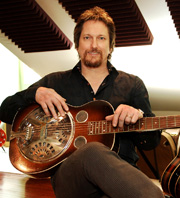The Diplomat of Dobro
Kim Green
OCTOBER 4, 2008
- Jerry Douglas and his Dobro
- (Courtesy Jerry Douglas)
- View the Slideshow
Web Resources
Related Stories
Around Nashville and pretty much everywhere else, Jerry Douglas's name is synonymous with the Dobro. The instrument has a distinctive look. It's an acoustic guitar with a shiny metal plate on the front, and you play it face-up in your lap with a metal slide, like a steel guitar.
When the Dobro came along earlier this century, purists saw it as the red-haired stepchild of bluegrass instruments, a usurper in a banjo's world. Douglas took up the instrument in the early seventies and changed all that. He's played on more than 2000 albums in pretty much all genres, with everybody you can imagine: Allison Kraus, Ray Charles, Phish, and John Fogerty to name a few. He's to the Dobro what Hendrix was to the electric guitar and Tiger is to the seven-iron.
Jerry Douglas led producer Kim Green through a musical tour of Dobro history when she visited his studio in Nashville.
---
Jerry Douglas: First of all, Dobro guitar was invented by five Czechoslovakian brothers. And this gets really convoluted really fast.
And just in short, Dobro guitar is short for "Dopyera Brothers." Their last name was Dopyera. And so they shortened it to Dobro, and it's sort of like "Kleenex," you know? Sort of a household name at this point.
And they had this love of Hawaiian music. But they didn't think that the guitars that the Hawaiian music players were loud enough. So they created this metal sort of concaved cone in the middle of the guitar with a really shiny cover plate on the outside that looks like a hubcap. To make the guitar louder. It works just like a speaker in your home stereo. And the sound goes down in and is reflected right back out really fast, and that's what makes it different than a regular guitar. They invented them to be used as Hawaiian guitars.
And it found its way into country music through, predominantly, a guy named Bashful Brother Oswald. And he got this job with Roy Acuff and started playing country music.
And so that was you know, a pretty simple way of playing. He played with his thumb and index finger. And then the next evolutionary step was through a fellow named Josh Graves, Buck Graves, who played with Lester Flatt and Earl Scruggs.
I saw Josh Graves and Bashful Brother Oswald play in Youngtown, Ohio. I was a little ten-year-old kid, and I saw them both play the same night, and it just put me over the top. I had to learn how to make that sound. Josh Graves' playing was more like a banjo in a way and also had a lot of blues influences.
And it really influenced me because I was waking up in the morning and listening to Flatt & Scruggs records, and then at night, being so close to Cleveland, Ohio, I was listening to rock-and-roll stations on a little transistor radio at night to go to sleep. So I was hearing the Beatles and the Stones at night, hearing Flatt & Scruggs in the morning. So I was a little confused musically. But so I ended up adapting a lot of that into my own playing.
So this instrument's sort of unlimited. It's not really been tested. It's just sort of been accepted, kind of. So I took it upon myself at that point to get attention for the instrument and then learn how to play the music and sound like I was there all along. OK, maybe this is an instrument that can do a lot of other things. And a lot of other people started realizing that too, and that's what really solidified my argument that it is an instrument for all genres of music.
When I was a little kid and played guitar and mandolin and all those things, I sang. And as soon as I started playing Dobro, I stopped singing. This freed me up from using language to get things across. Because I am actually singing, but it's coming through this instrument.
It's just a conduit. It's something to get these emotions and all these ideas out through instead of singing it. This is my voice. This is what I talk with.







Comments
Comment | Refresh
From Chicago, IL, 10/05/2008
Here's a historical link. Watch carefully and you can witness a Dobro.
http://www.youtube.com/watch?v=1dTU_RvjTY4&feature=related
From Chicago, IL, 10/05/2008
Followup question about the Dobro. Why is played sideways? Seems like that would send the sound up, not out, which is why the brothers invented it. Is it easier to play that way? How is that different than a regular guitar? Also, was this the bridge to the steel guitar's birth? I'm really interested in this!
From Chicago, IL, 10/04/2008
Wow! What a great music history lesson. I had no idea. I'm a blues freak, which is what hooked me into this, but the Dubro crosses many lines. This story was a 10!
From Boonville, MO, 10/04/2008
I got chills listening to Jerry Douglas on the Dobro! I am very despondent and depressed! I heard you say that he is at the Columbia, MO "Roots and Blues Festival". I will not be going this year! I'm only 20 miles from Columbia!! Curses!!!
Post a Comment: Please be civil, brief and relevant.
Email addresses are never displayed, but they are required to confirm your comments. All comments are moderated. Weekend America reserves the right to edit any comments on this site and to read them on the air if they are extra-interesting. Please read the Comment Guidelines before posting.
You must be 13 or over to submit information to American Public Media. The information entered into this form will not be used to send unsolicited email and will not be sold to a third party. For more information see Terms and Conditions and Privacy Policy.